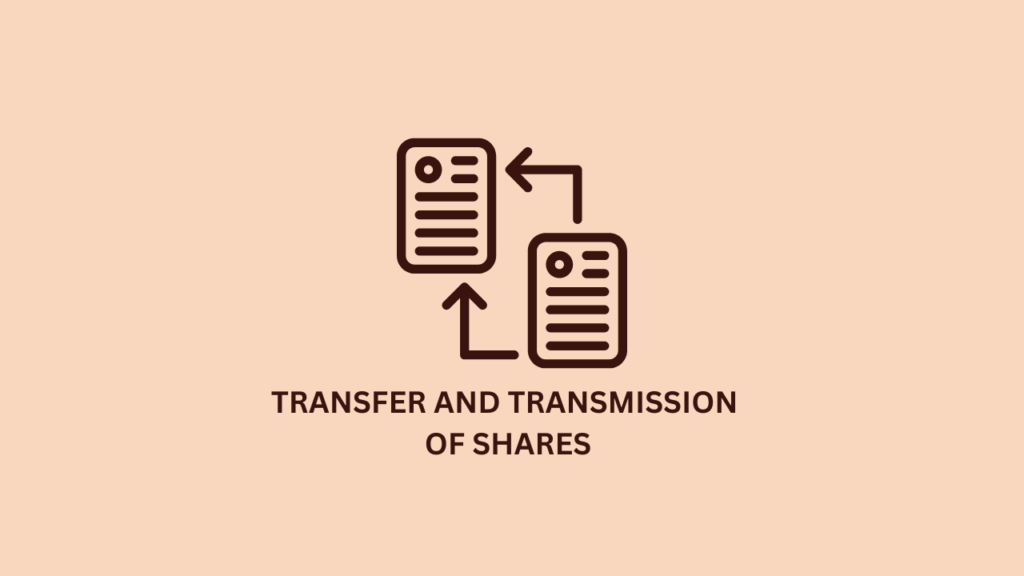
The transmission and transfer of securities is a crucial aspect of financial management. An overview of these procedures as outlined in the Securities Contracts (Regulation) Act of 1956 and the Companies Act of 2013 is given in this blog. The Securities Contracts (Regulation) Act of 1956 and the Companies Act of 2013 provide the legal foundation for the transmission and transfer of securities. These consist of any marketable securities that are issued by an incorporated business, such as bonds, debentures, derivatives, and shares.
The method for transferring securities step-by-step and for transmitting securities when ownership changes as a result of legal action are covered in the handbook. This includes a thorough examination of the procedure for transferring shares that have been partially paid, which entails extra measures including giving the transferee notice.
-Section 2(81) of the Companies Act, 2013
-Section 2(h) of Securities Contracts (Regulation) Act, 1956
-Section 56 of the Companies Act, 2013
-Rule 11 of The Companies (Share Capital and Debentures) Rules, 2014
2.Definitions:
The securities described in clause (h) of Section 2 of the Securities Contracts (Regulation) Act, 1956 are referred to as “securities” under Section 2(81) of the Companies Act, 2013.
According to Section 2(h) of the Securities Contracts (Regulation) Act, 1956, “Securities” include derivatives; units or any other instrument issued by any collective investment scheme to the investors in such schemes; security receipts as defined in Clause of Section 2 of the Securitization and Reconstruction of Financial Assets and Enforcement of Security Interest Act, 2002; units or any other such instrument issued to the investors under any mutual fund scheme;
Government securities, rights or interests in securities, and any other instruments that the Central Government may designate as securities.
3.Process for Transfer of Securities:
1. Transfer of securities or interest from one individual to another, with that person’s identity recorded in the member registry Certain limitations apply to the transfer of a private company’s shares.
2. Complete the transfer instrument in Form SH-4, including the following: Date of Completion Securities Type and Class The nominal worth of every security Amount requested for each security Total amount paid for each security The quantity of securities that needed to be moved Taking into Account Acquired Transferor Information with signature Transferee Information with signature and witness signature appropriate stamp by the Stamp Act
3. Within sixty days of the date of execution, the transferor or the transferee must provide the company with the signed and properly executed Form SH-4.
4. Within sixty days from the date of execution, the transferor or the transferee must provide the firm with the signed and properly executed Form SH-4.
5. Within a month of receiving the transfer instrument, the Company is required to deliver the share certificate.
4.Process for transfer of partly paid shares:
1.The transferee must receive notice in Form SH-5 before registering the transfer of partially paid-up shares.
2.Within two weeks of receiving notification, the transferee must indicate whether or not they oppose.
Individuals and organisations alike must comprehend the procedures involved in sending and exchanging shares. By adhering to the established protocols, transactions run smoothly and any legal concerns are avoided. A strong framework is provided by the Companies Act of 2013 and the Securities Contracts (Regulation) Act of 1956 to guarantee that these procedures are carried out accurately and preserve the integrity of the financial markets.
When two businesses merge, their boards of directors authorise the union and ask the shareholders for their consent. For instance, in 1998, the Digital Equipment Corporation and Compaq entered into a merger agreement wherein Compaq acquired the Digital Equipment Corporation. Later, in 2002, Compaq and Hewlett-Packard combined. CPQ was Compaq’s pre-merger ticker symbol. The present ticker symbol (HPQ) was created by combining this with the Hewlett-Packard ticker sign (HWP).
In a straightforward acquisition, the acquiring business buys the bulk of the acquired company, which keeps its original name and organisational structure. The 2004 acquisition of John Hancock Financial Services by Manulife Financial Corporation, in which both businesses kept their names and organisational structures, is an illustration of this kind of deal. Six By using a whitewash resolution, the target company may demand that the purchasers guarantee that the target business will continue to operate profitably for a certain amount of time following acquisition.
By merging key operations and doing away with outdated corporate frameworks, consolidation results in the creation of a new corporation. Following their acceptance, shareholders of both firms will get common equity shares in the combined company. The consolidation requires their permission. For instance, the 1998 announcement of a merger between Citicorp and Travellers Insurance Group led to the creation of Citigroup.
In a tender offer, one business proposes to pay a certain amount instead of the going rate for the other business’s outstanding stock. By passing the management and board of directors, the purchasing business makes the offer directly known to the other company’s shareholders. For instance, Johnson & Johnson submitted a $438 million tender offer to purchase Omrix Biopharmaceuticals in 2008. By the end of December 2008, the agreement had been finalised when the company accepted the tender offer.
An asset acquisition occurs when a business directly buys the assets of another business. The shareholders of the company whose assets are being acquired must provide their permission. During bankruptcy procedures, it is common for other companies to bid for different assets of the insolvent company. The bankrupt company is then liquidated upon the ultimate transfer of assets to the purchasing firms.
In a management acquisition, which is often referred to as a management-led buyout (MBO), the executives of one firm acquire a majority stake in another, therefore bringing it private. In an attempt to assist with financing a transaction, these former CEOs frequently collaborate with financiers or former corporate officers. These M&A deals usually require the approval of the majority of shareholders and are financed mostly through debt. For instance, Dell Corporation declared in 2013 that its founder, Michael Dell, had purchased the company.

